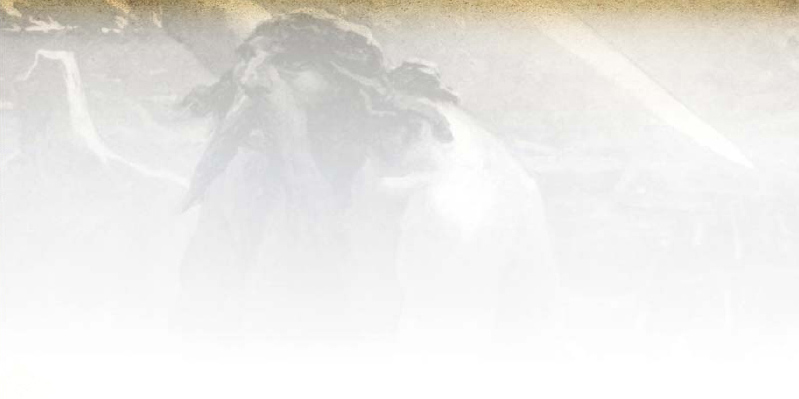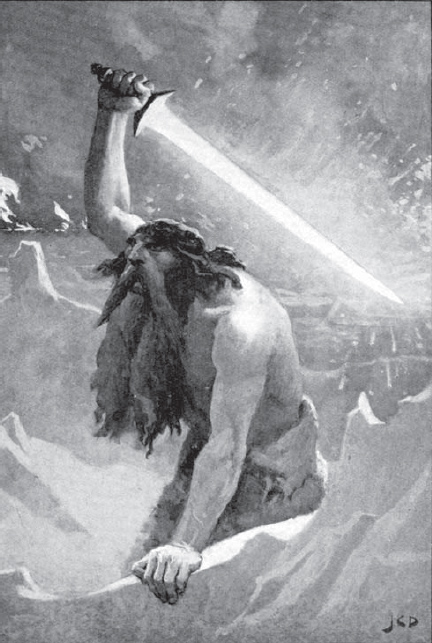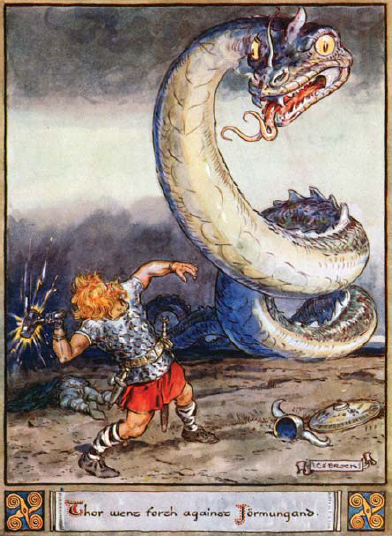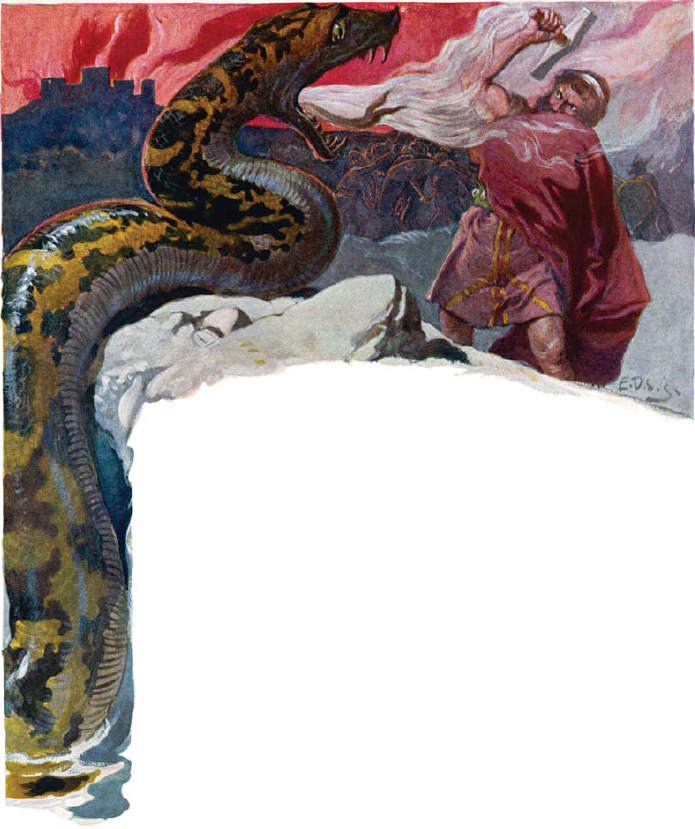

Norse mythology is unlike the mythologies of most other cultures in that it contains a detailed description of the end of the world, in which even the gods are killed.
There are two main sources for the events of Ragnarok. The Poetic Edda contains a poem called Voluspa, in which a volva or seeress gives Odin a detailed prophecy about the end of the world. In Gylfaginning, in the Prose Edda, another account is given as part of a general account of the world and the gods: this quotes extensively from the Voluspa.
Ragnarok is mentioned in several other places in the Eddas, but only in passing. Usually a character taunts one of the gods with something from the prophecy, as when Loki taunts Thor with the fact that he will not save Odin from the wolf Fenrir.
The Old Norse word “Ragnarok” can be translated as “the fate of the gods.” In one place in the Lokasenna a slightly different word-form is used, which may be an accidental misspelling or a deliberate variation: ragnarøkkr instead of ragnarok. The translation of ragnarøkkr is “twilight of the gods,” and it was taken by Richard Wagner as the title of the fourth opera in his Ring Cycle, Gotterdämmerung.
Ragnarok will begin with Fimbulvetr (“the great winter,” Fimbulwinter), a harsh and stormy winter that lasts for three years with no intervening summers. During this time, war and discord spread across the whole world. Family loyalty and other social ties break down completely as brothers kill their brothers for material gain:
There are axe-ages, sword-ages,
Shields are cleft in twain,
There are wind-ages, wolf-ages,
Ere the world falls dead.
The Voluspa
Fimbulwinter will destroy all life in Midgard, except for a woman named Lif and a man named Lifthrasir (“Life” and “Lover of Life”) who survive by hiding in a deep forest called Hoddmimis holt. The location of this forest is unclear. Its name translates as “Hoard-Mimir’s Wood.” Mimir was a god of great wisdom who lost his head during a war between the Aesir and the Vanir. Odin consults Mimir’s severed head for advice in this myth and others.
At the end of Fimbulwinter, a number of prodigious events take place. A great wolf swallows the sun, and another the moon. The stars are hurled down from the heavens. The earth is wracked by violent earthquakes that uproot trees and tumble mountains.

Surtur with his flaming sword. John Charles Dollman, 1909. (PD-US)
The wolf Fenrir breaks loose from the bonds in which he was placed by the Aesir. The Midgard Serpent stirs, thrashing in the sea and causing great waves to cover the land. Upon this flood comes Naglfari (“the ship of nails”), which is made from the nails of dead men. In some sources Loki stands at the tiller; in others, it is a giant named Hrym (“the decrepit”). The ship carries a horde of enemies who are not named, although Loki is said later to be leading the hordes of Hel and Thrym the Hrimthursar, or Frost Giants of Niflheim.
Fenrir and the Midgard Serpent advance side by side toward Bifrost, the rainbow bridge that connects the mortal realm of Midgard with the Aesir’s home of Asgard. Fenrir gapes so wide that his jaws span heaven and earth, and fire shoots from his eyes and nostrils. The Midgard Serpent vomits a flood of venom that covers the land and fouls the air. They cause such devastation that the heavens are torn in two.
Through the breach created by Fenrir and Jormungand come the Fire Giants of Muspelheim, led by their king Surtur. Wreathed in fire and wielding a sword brighter than the sun, Surtur destroys the rainbow bridge as his forces ride over it.
Heimdall, the god who watches over the rainbow bridge, sounds the horn Gjallarhorn to raise the alarm. Odin rides to Mimir’s Well to consult the oracular head before returning to lead the Aesir into battle. The world-tree Yggdrasil begins to shake, and fear spreads throughout all creation. The final battle is about to be joined.
The enemies of Asgard assemble on the field of Vigridr (“Surge of Battle”), which is one hundred rasts (almost 702 miles) on each side. Their forces are named as follows:
The wolf Fenrir and the Midgard Serpent Jormungand;
The Fire Giants, commanded by Surtur;
The hordes of Hel, commanded by Loki;
The Frost Giants, commanded by Thrym.
Against them are ranged the Aesir and the einherjar, those warriors who were chosen by the Valkyries and brought from the battlefield to Odin’s hall at Valhalla, where they have spent the ages fighting all day and feasting all night.
The final battle is described as a series of individual combats, in which the gods fall one by one.
Odin, clad in bright mail and wielding his magical spear Gungnir, fights the wolf Fenrir. Thor stands beside him, but is locked in battle with the Midgard Serpent and unable to prevent Fenrir from slaying Odin.
Frey, the god of peace and fertility, faces the Fire Giant king Surtur, and is overcome after a fierce battle. It is said that Frey might have defeated Surtur if he had had his magical sword, which is capable of fighting on its own. However, he had lent it to his servant Skirnir, and falls before Surtur’s fiery blade.

Thor fights the Midgard Serpent at Ragnarok. Book illustration by Charles Edmund Brock, 1930. (The Bridgeman Art Library)
One-handed Tyr battles Garm, the monstrous dog that guarded the entrance to Hel, and they are both killed in the conflict.
After a hard struggle, Thor succeeds in killing the Midgard Serpent. However, he has little time to enjoy his victory. Overcome by the floods of venom that the dying Jormungand vomits forth, Thor staggers back nine paces and falls dead.
Meanwhile, Fenrir has swallowed Odin. Vidar, Odin’s son by the giantess Gridr, steps forward and pries the wolf’s jaws apart, tearing him to pieces (or, according to the Voluspa, stabbing him in the heart). Heimdall fights with Loki, and they kill each other.
As Fenrir, Loki, and Heimdall fall, Surtur flings fire over the earth, and the whole universe is consumed in the conflagration.

The Midgard Serpent spews forth a flood of venom, poisoning Thor as he kills it. (Mary Evans Picture Library)
After the flames subside, a new world, pleasant and fertile, will rise from the sea. Six gods are named as surviving Ragnarok: Vidar and his brother Vali, Thor’s sons Modi and Magni, and the two dead gods Balder and Hod, who are released from Hel in this new age. They dwell peacefully in the plain of Ida, where Asgard formerly stood.
Lif and Lifthrasir emerge from the forest and feed on the morning dew. Their descendants will spread across the earth. A daughter of the sun, more beautiful than her mother, will take her place in the sky and bring light to the world.
It appears that these few are not alone in this new world. The righteous dwell in Gimle, where good and plentiful drink awaits them in the hall of Brimer. Snorri equates this with the Christian heaven. Another hall, made of red gold and called Sindre, stands on the Nida Mountains to the north, in what used to be the cold and gloomy realm of Niflheim.
However, all is not peace and plenty in this new world. The terrible hall of Nastrond (shores of the dead) is the abode of perjurers, adulterers and murderers. Its doors face north, letting in a bitter wind. Its walls are woven of living snakes that continually belch forth venom and those inside are forced to wade through streams of the poison.
Hvergelmir (“bubbling, boiling spring”) is said to be even worse. Set in the former realm of Hel, it is inhabited by the terrible dragon Nidhogg, who sucks on the corpses of the dead.

At a feast in Aegir’s hall, Loki insults all the gods in turn. He only leaves when Thor threatens him. (See p.29)